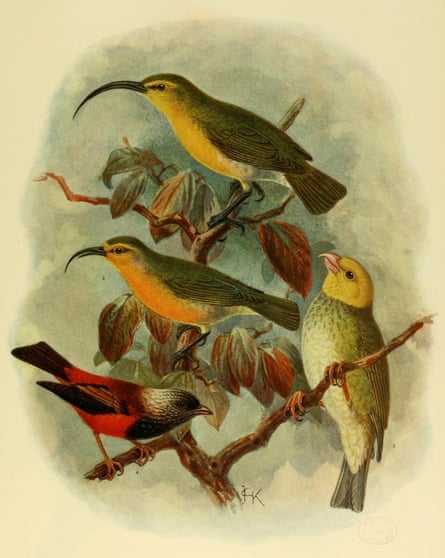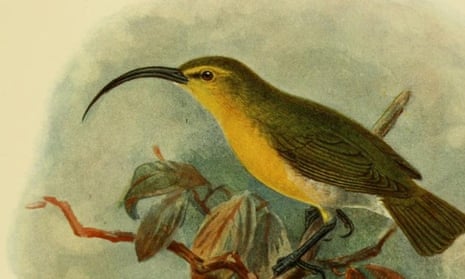In 1907, avid zoologist Walter Rothschild had a go at bringing all the bird species that had gone extinct within historical times together between the covers of a single volume. It is a “melancholy fact”, he wrote in Extinct Birds, “that man and his satellites, cats, rats, dogs, and pigs are the worst and in fact the only important agents of destruction of the native avifaunas wherever they go.” In spite of the melancholy, this is still a rather wonderful book, boasting 45 coloured plates by Netherlands-born artist John Gerrard Keulemans.
The Hawaiian honeycreepers show an amazing variety of bill shapes and present one of the finest examples of adaptive radiation anywhere in the world (though I think the bulimulid snails in the Galapagos might be still more impressive). There are over 50 known species of honeycreeper, most of which no longer exist owing to a combination of factors like habitat destruction, invasive species and disease. In this plate, Rothschild has chosen four of them.

The taxonomy has changed a fair bit since he published this book and I’ve done my best to infer the current species names. At the top of the plate is a greater akialoa (Hemignathus ellisianus) from Oahu, its impressively decurved bill an adaptation for accessing the nectar of native flowers. Directly beneath it is a nukupuu (Hemignathus lucidus) also from Oahu. This species, Rothschild reports, had been common in the early 19th century, recorded “in great numbers flying round the flowers of the banana plantations.” On Maui, the nukupuu held out for longer, the last individual seen there in the 1990s and technically the species has not yet been declared extinct. Oriented vertically on the right of the image is an ou (Psittirostra psittacea), a species that in Rothschild’s day had already disappeared from several islands in the Hawaiian chain. Its bill is adapted for feeding on a crawling vine. Bottom left is a male ula-ai-hawane (Ciridops anna), a species known from just five specimens. Two of these were in Rothschild’s possession at Tring in Hertfordshire.

Comments (…)
Sign in or create your Guardian account to join the discussion